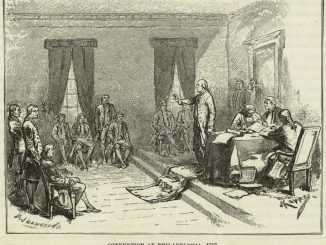
Principles of Constitutional Interpretation
People attempt to interpret the principles of the Constitution (constitutional interpretation) and get it wrong because of faulty technique or trying to bend it to their own agenda. Read below and let’s explore a better understanding of the Constitution…
I studied Pre-Constitutional Law and Political Science at Texas A&M and most of my information is from my time in pursuit of my degree. Remember: If the Constitution was simple and easy to understand, we wouldn’t need the Supreme Court!
Constitutional interpretation, or constitutional construction, the term more often used by the Founders, is the process by which legal decisions are made that are justified by a constitution, although not necessarily correctly. Constitutional controversies are about whether an official act is consistent with, and authorized by, a constitution or constitutional statute or court decision. Since a constitution is a law, and the supreme law within its domain, and authorizes statutes and other official acts which have a textual expression, the principles of constitu

tional interpretation are essentially the same as the principles of statutory or judicial interpretation.
Most legal scholars recognize seven main methods of interpretation: textual, historical, functional, doctrinal, prudential, equitable, and natural. Although constitutional scholars may differ on what each includes, and there is some overlap among them.
Seven Methods of Interpretation –
1. Textual:
Decision based on the actual words of the written law, if the meaning of the words is unambiguous. Since a law is a command, then it must mean what it meant to the lawgiver, and if the meaning of the words used in it have changed since it was issued, then textual analysis must be of the words as understood by the lawgiver, which for a constitution would be the understanding of the ratifying convention or, if that is unclear, of the drafters. Some Latin maxims: A verbis legis non est recedendum. From the words of the law there is not any departure. 5 Coke 118. Noscitur à sociis. Meaning of words may be ascertained by associated words. 3 T.R. 87.
2. Historical:
Decision based less on the actual words than on the understanding revealed by analysis of the history of the drafting and ratification of the law, for constitutions and statutes, sometimes called its legislative history, and for judicial edicts, the case history. A textual analysis for words whose meanings have changed therefore overlaps historical analysis. It arises out of such Latin maxims as Animus hominis est anima scripti. Intention is the soul of an instrument. 3 Bulst. 67.
3. Functional:
Also called structural. Decision based on analysis of the structures the law constituted and how they are apparently intended to function as a coherent, harmonious system. A Latin maxim is Nemo aliquam partem recte intelligere potest antequam totum perlegit. No one can properly understand a part until he has read the whole. 3 Coke Rep. 59.
4. Doctrinal:
Decision based on prevailing practices or opinions of legal professionals, mainly legislative, executive, or judicial precedents, according to the meta-doctrine of stare decisis, which treats the principles according to which court decisions have been made as not merely advisory but as normative. Some Latin maxims are: Argumentum à simili valet in lege. An argument from a like case avails in law. Coke, Littleton, 191. Consuetudo et communis assuetudo . . . interpretatur legem scriptam, si lex sit generalis. Custom and common usage . . . interpret the written law, if it be general. Jenk. Cent. 273. Cursus curiæ est lex curiæ. The practice of the court is the law of the court. 3 Buls. 53. Judiciis posterioribus fides est adhibenda. Credit is to be given to the latest decisions. 13 Coke 14. Res judicata pro veritate accipitur. A thing adjudicated is received as true. Coke, Littleton, 103.
5. Prudential:
Decision based on factors external to the law or interests of the parties in the case, such as the convenience of overburdened officials, efficiency of governmental operations, avoidance of stimulating more cases, or response to political pressure. One such consideration, avoidance of disturbing a stable body of practices, is also the main motivation for the doctrinal method. It also includes such considerations as whether a case is “ripe” for decision, or whether lesser or administrative remedies have first been exhausted. A Latin maxim is Boni judicis est lites dirimere. The duty of a good judge is to prevent litigation. 4 Coke 15.
6. Equitable:
Also called ethical. Decision based on an innate sense of justice, balancing the interests of the parties, and what is right and wrong, regardless of what the written law might provide. Often resorted to in cases in which the facts were not adequately anticipated or provided for by the lawgivers. Some scholars put various balancing tests of interests and values in the prudential category, but it works better to distinguish between prudential as balancing the interests and values of the legal system from equitable as balancing the interests and values of the parties. It arises out of the Latin maxim, Æquitas est perfecta quædam ratio quæ jus scriptum interpretatur et emendat; nulla scriptura comprehensa, sed sola ratione consistens. Equity is a sort of perfect reason which interprets and amends written law; comprehended in no code, but consistent with reason alone. Coke, Littleton, 24.
7. Natural:
Decision based on what is required or advised by the laws of nature, or perhaps of human nature, and on what is physically or economically possible or practical, or on what is actually likely to occur. This has its origin in such ancient Latin maxims as: Jura naturæ sunt immutabilia. The laws of nature are unchangeable. Jacob. 63. Impossibilium nulla obligatio est. There is no obligation to do impossible things. D. 50, 17, 185. Lex non cogit ad impossibilia. The law does not compel the impossible. Hob. 96. Lex neminem cogit ad vana seu inutilia peragenda. The law requires no one to do vain or useless things. 5 Coke 21. Legibus sumptis desinentibus, lege naturæ utendum est. Laws of the state failing, we must act by the law of nature. 2 Rol. Rep. 98.
The Interpretation –
Within these methods, we can, by study of the writings of the Founders and the writings they read, elicit such principles for interpretation of the Constitution for the United States as the following:
1. The Constitution is the written document.
Although it may be considered to include the understandings of its words as of the time of ratification, it does not include the subsequent body of practices or precedents upon which constitutional decisions might be based, which may or may not be consistent with it, or authorized by it. The written document refers to itself as “this Constitution”, and provides for only four methods by which it may be amended, all of which apply only to the written document.
2. The authority for provisions of the Constitution…
…is the ratifications and state admissions. Current consent or acquiescence, or lack thereof, to the Constitution or any practice, does not affect the original constitutive acts, and has no authority, unless expressed through adoption of amendments as provided in Article V.
3. Provisions of the Constitution are mutually consistent.
There are no internal logical contradictions, except that a provision of an amendment inconsistent with a previous provision supersedes that provision.
4. None of the words are without force and effect,…
…except those superseded by amendments, unless such amendments are repealed. Except for the statement of purpose in the preamble, every word was intended by the Framers to be legally normative, and not just advisory, declaratory, aspirational, or exhortatory. Verba intelligi ut aliquid operantur debent. Words should be interpreted to give them some effect.
5. Rights and powers are complementary.
Every right recognized by the Constitution is an immunity, that is, a right against a positive action by government, and is equivalent to a restriction on delegated powers. Conversely, every delegated power is a restriction on immunities. An immunity may be expressed either as a declaration of the right, or as a restriction on powers.
6. There are no redundancies within the original unamended Constitution.
However, amendments may be alternative ways of expressing equivalent content in the original unamended Constitution or previous amendments. More specifically, the Bill of Rights added no new content not implicit in the original unamended Constitution, except the twenty dollar rule of the Seventh Amendment.
7. The Constitution was intended to define a functionally complete and harmonious system.
That does not mean, however, that all powers anyone might think the nation or any branch, level, office or department should have, were actually delegated.
8. Original “intent” is functional, not motivational.
The private motives of the Framers or Founders are irrelevant and largely unknowable, and likely to have been diverse. The common law rule of interpretation understood by the Founders was to discern the functional role of elements of the law, not the private purposes of the lawgivers.
9. The power to regulate is not the power to prohibit all modalities of something.
It is only the power to issue prescriptions to “make regular”, enforceable only by deprivations of property or privileges, not of life, limb, or liberty. There must always be some modality that is not prohibited.
10. Implied powers are only to “carry into Execution” an expressed power…
…and not to do whatever is necessary to achieve the intent for which a power might be exercised. Delegation of a power is delegation of the right to make a certain kind of effort, not to do whatever is necessary to get a desired outcome.
11. There can be no common law crimes.
They are in conflict with the prohibitions on ex post facto laws and bills of attainder.
12. Rights may not be disabled or unduly burdened by legislative or executive process.
“Due” process is judicial only, involving the granting of a petition to disable a right of the defendant, with the burden of proof on the plaintiff or prosecutor, and with the defendant having at least those minimum protections that prevailed during the Founding. with similar disablements having similar standards of proof and protection.
13. There is no right without a remedy.
Ubi jus ibi remedium. There must always be an accessible forum in which a complainant has oyer and terminer for any petition.
14. The ratification debates are the best evidence of original understanding.
The arguments of those opposed to ratification are not just the positions of the losers in the debates, which some might dismiss as not indicative of original understanding. As the debates proceeded, understandings evolved and clarified, and positions changed. Most opponents were satisfied by adoption of a Bill of Rights, and by assurances by the proponents concerning how the words of the Constitution would be interpreted, and those assurances must be considered part of the original understanding. That means that a construction to which the more significant “anti-federalists” would object is almost certainly incorrect.
15. Powers are narrow, rights broad.
The entire theme and tenor of the ratification debates was that delegated powers were to be interpreted as strictly as possible, consistent with the words, and rights as broadly as possible, with the presumption in favor of the right, and the burden of proof on those claiming a power. Potestas stricte interpretatur. A power is strictly interpreted. In dubiis, non præsumitur pro potentia. In cases of doubt, the presumption is not in favor of a power.
16. Delegated powers cannot be subdelegated.
The U.S. Constitution vests all legislative powers in Congress, and all judicial powers in the Supreme Court and inferior courts, except as specifically expressed. Executive branch officials may subdelegate but must remain responsible for the actions of their subordinates. There can be no authority exercised that is not accountable through constitutional officials.Delegata potestas non potest delegari. A delegated power cannot be delegated. 9 Inst. 597.






What was the 18th c. meaning of “regular”, as in the Congressional task of keeping the currency “regular”? Did the Founders think in (modern) terms of constancy of purchasing power per dollar over time , for example?
Our understanding of the Founders’ intent was that “regular” currency equated to a standard currency for the nation that held established value. When paper money was finally approved, there was intent for it to have steady, stated value.